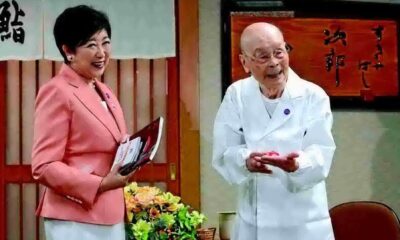Science
Researchers Uncover Key Regulators of Protein Synthesis in ALS

Research conducted by a team from the Center for Cellular Regulation Engineering at Science Tokyo has identified critical factors involved in the abnormal protein synthesis associated with neurodegenerative disorders. Specifically, the study focuses on the mutated C9orf72 gene, which is linked to conditions such as amyotrophic lateral sclerosis (ALS) and frontotemporal dementia (FTD). The findings were published in the journal Nucleic Acids Research.
Utilizing a human cell-free translation system, the researchers reconstructed the aberrant translation process of the mutated C9orf72 gene. They discovered that two translation factors, eIF1A and eIF5B, play crucial roles in repressing a toxic protein synthesis mechanism associated with these neurodegenerative diseases. This process, known as repeat-associated non-AUG (RAN) translation, deviates from the typical protein synthesis pathway by initiating from non-AUG codons instead of the standard AUG codon.
Neurodegenerative disorders pose a significant challenge in modern medicine, with many of their underlying causes still being poorly understood. Genetic mutations, particularly in the C9orf72 gene, contribute to the abnormal repetition of DNA sequences, which can trigger harmful cellular processes. These mutations lead to the production of toxic proteins that accumulate in neurons, causing damage and contributing to disease progression. Despite recognizing the existence of these toxic proteins, the specific regulatory mechanisms controlling RAN translation have remained elusive.
In a bid to clarify these mechanisms, the research team, led by Professor Hideki Taguchi, adopted a bottom-up approach. “Though there are previous studies on the repeat sequences associated with neurodegenerative diseases, the role of non-canonical translation like RAN translation remains unexplored,” Taguchi explained. The aim was to identify potential regulators of RAN translation using a systematic screening method.
The researchers employed the innovative human factor-based reconstituted translation system, known as human PURE, developed by scientists from the University of Hyogo. This system faithfully reproduces the C9orf72-mediated RAN translation process outside of living cells, utilizing highly purified human translation components. This approach allowed the team to focus specifically on the non-AUG initiation mechanisms without interference from cellular responses.
Through their systematic screening, the researchers identified that the translation initiation factors eIF1A and eIF5B act as repressors of RAN translation at two critical checkpoints. eIF1A suppresses C9-RAN translation during the initial scanning phase by promoting the correct selection of the start codon. Meanwhile, eIF5B exercises translational control during the post-scanning phase, overseeing the assembly of the ribosomal subunits.
“The successful in vitro reconstitution of abnormal protein synthesis enabled the detailed elucidation of the mechanisms of action of eIF1A and eIF5B,” remarked Taguchi, emphasizing the significance of their findings. Further validation in human cells confirmed that eIF1A and eIF5B operate through independent and additive mechanisms to repress RAN translation.
An intriguing aspect of the research is its connection to cellular stress. The team found that when cells experience stress, C9-RAN translation typically increases. However, this increase was completely abolished in the absence of eIF1A, highlighting its essential role in the stress response related to C9-RAN translation.
By identifying eIF1A and eIF5B as key regulators, this study enhances our understanding of the mechanisms that contribute to ALS and FTD. Taguchi concluded, “These newfound insights provide a foundation for developing technologies to control RAN translation, paving the way for novel therapeutic strategies against neurodegenerative diseases.”
The research marks a significant step forward in the quest to unravel the complexities of neurodegenerative disorders and may lead to new avenues for treatment in the future. For further details, refer to the study by Hayato Ito et al., “Canonical translation factors eIF1A and eIF5B modulate the initiation step of repeat-associated non-AUG translation,” published in Nucleic Acids Research in 2025.
-

 Technology5 months ago
Technology5 months agoDiscover the Top 10 Calorie Counting Apps of 2025
-

 Technology3 weeks ago
Technology3 weeks agoOpenAI to Implement Age Verification for ChatGPT by December 2025
-

 Health3 months ago
Health3 months agoBella Hadid Shares Health Update After Treatment for Lyme Disease
-

 Health3 months ago
Health3 months agoAnalysts Project Stronger Growth for Apple’s iPhone 17 Lineup
-

 Health4 months ago
Health4 months agoErin Bates Shares Recovery Update Following Sepsis Complications
-

 Technology5 months ago
Technology5 months agoDiscover How to Reverse Image Search Using ChatGPT Effortlessly
-

 Technology3 months ago
Technology3 months agoElectric Moto Influencer Surronster Arrested in Tijuana
-

 Technology5 months ago
Technology5 months agoMeta Initiates $60B AI Data Center Expansion, Starting in Ohio
-

 Technology2 months ago
Technology2 months agoDiscover 2025’s Top GPUs for Exceptional 4K Gaming Performance
-

 Technology5 months ago
Technology5 months agoRecovering a Suspended TikTok Account: A Step-by-Step Guide
-

 Health5 months ago
Health5 months agoTested: Rab Firewall Mountain Jacket Survives Harsh Conditions
-

 Lifestyle5 months ago
Lifestyle5 months agoBelton Family Reunites After Daughter Survives Hill Country Floods





















